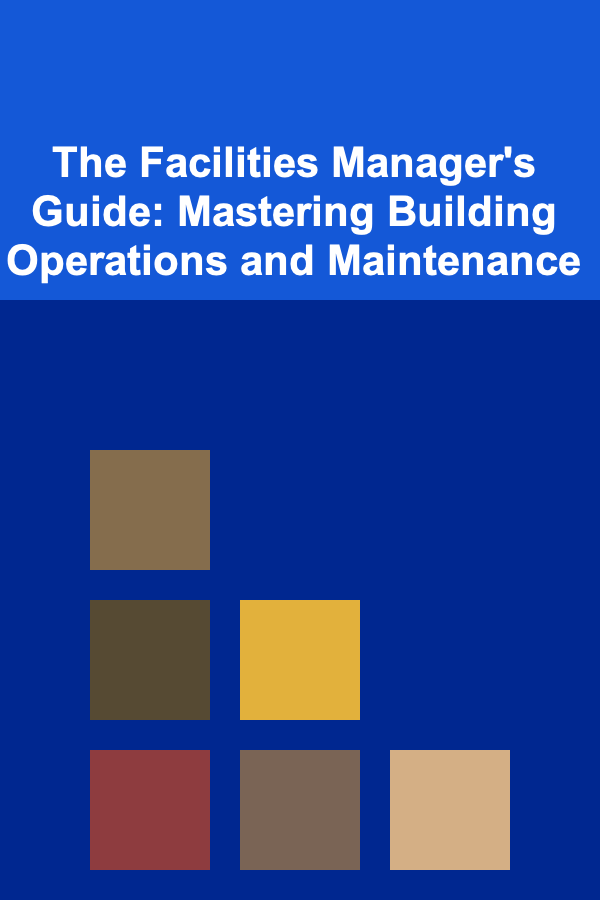
The Facilities Manager's Guide: Mastering Building Operations and Maintenance
ebook include PDF & Audio bundle (Micro Guide)
$12.99$9.99
Limited Time Offer! Order within the next:

Facilities management is a critical aspect of ensuring the smooth operation, safety, and sustainability of any building. A facilities manager plays a central role in the day-to-day functioning of a building, overseeing everything from maintenance to safety, energy efficiency, and tenant satisfaction. The goal is not only to keep the building running efficiently but also to create a productive and pleasant environment for the people who use it.
In this comprehensive guide, we will delve into key strategies and best practices for mastering building operations and maintenance. These actionable insights will help facilities managers optimize operations, reduce costs, ensure regulatory compliance, and enhance the overall user experience.
Implementing Preventive Maintenance Programs
One of the most effective ways to reduce downtime, improve asset longevity, and control costs is through preventive maintenance. This proactive approach focuses on addressing potential issues before they become serious problems. Preventive maintenance helps avoid costly emergency repairs and improves the overall lifespan of equipment and systems.
Key Elements of Preventive Maintenance
- Scheduled Inspections: Regularly inspect critical systems such as HVAC, plumbing, electrical, and fire safety equipment. Create a maintenance calendar and stick to it to ensure that all components are checked periodically.
- Predictive Maintenance: Leverage data-driven solutions, such as sensors or IoT technology, to predict when a piece of equipment is likely to fail. This allows for timely interventions before problems occur.
- Record Keeping: Maintain detailed logs of all maintenance activities, repairs, and inspections. These records help track the history of each asset and can be used to spot recurring issues.
Actionable Steps:
- Use a CMMS (Computerized Maintenance Management System) to streamline and automate preventive maintenance schedules. A CMMS can generate reminders for inspections, track repair histories, and help prioritize maintenance tasks.
- Invest in predictive tools like vibration sensors, temperature gauges, or IoT-enabled devices to monitor equipment conditions in real time and predict failures before they happen.
- Train your maintenance team to conduct inspections effectively and identify potential issues early. This can help reduce response time and prevent disruptions to building operations.
By adopting a preventive maintenance strategy, you can reduce the frequency of costly emergency repairs, extend the lifespan of equipment, and ensure that your building remains safe and functional.
Maximizing Energy Efficiency
Energy management is an ongoing concern for facilities managers. With rising energy costs and increasing pressure to meet sustainability goals, optimizing energy efficiency should be a top priority. By improving energy usage, facilities managers can reduce operating costs, improve environmental impact, and enhance occupant comfort.
Energy Efficiency Strategies:
- Building Automation Systems (BAS): Implementing BAS allows you to control lighting, HVAC systems, and other building systems from a centralized platform. With smart algorithms, BAS can adjust temperature settings, lighting, and ventilation based on occupancy or time of day, optimizing energy usage.
- Energy Audits: Conduct periodic energy audits to assess how energy is being used in the building. Identify areas of inefficiency, such as outdated HVAC units, improper insulation, or wasteful lighting practices.
- LED Lighting: Switching to LED lighting not only saves energy but also reduces maintenance costs since LEDs last longer than traditional incandescent or fluorescent lights.
Actionable Steps:
- Monitor Energy Consumption: Use energy management software to track the building's energy usage in real time. Identify trends and areas where energy can be saved, such as reducing heating or cooling when spaces are unoccupied.
- Upgrade to Energy-Efficient Systems: Replace outdated equipment with energy-efficient alternatives. Consider upgrading HVAC systems to energy-efficient models, adding insulation to reduce heat loss, or installing smart thermostats for better control.
- Involve Occupants in Energy-Saving Practices: Educate building occupants on energy conservation practices, such as turning off lights when not in use, using power strips to easily disconnect electronics, and utilizing natural light whenever possible.
By implementing these energy-saving strategies, facilities managers can significantly reduce energy consumption, lower utility costs, and help meet sustainability goals.
Ensuring Regulatory Compliance
Compliance with safety, health, and environmental regulations is crucial for any facilities manager. Not only is it essential for legal and ethical reasons, but it also helps create a safe and healthy environment for building occupants.
Key Areas of Compliance:
- Occupational Health and Safety (OHS): Facilities must comply with regulations related to worker safety, such as ensuring proper signage, hazard communication, and employee training.
- Fire Safety: Regular inspections of fire alarms, sprinklers, and fire extinguishers are required to maintain fire safety standards. Additionally, emergency evacuation plans should be clear and well-practiced.
- Accessibility Compliance: Ensure that the building complies with accessibility laws, such as the Americans with Disabilities Act (ADA), by providing ramps, elevators, and accessible restrooms.
Actionable Steps:
- Establish a Compliance Calendar: Create a calendar for regular safety checks, inspections, and audits. This ensures that nothing is overlooked and that all required certifications and permits are up to date.
- Invest in Compliance Management Software: Use software tools to track safety inspections, compliance requirements, and certifications. This helps automate processes and ensures timely compliance with regulations.
- Train Staff on Safety Protocols: Regularly conduct training sessions for staff on safety protocols, emergency procedures, and compliance regulations. This prepares employees for any emergencies and reduces the risk of accidents.
By staying proactive about compliance, facilities managers can mitigate risks, avoid legal liabilities, and ensure a safe and accessible environment for all building occupants.
Leveraging Technology for Efficiency
Technology is transforming facilities management, enabling more efficient operations, better decision-making, and enhanced service delivery. From software tools to IoT devices, technology can significantly streamline building operations.
Key Technologies in Facilities Management:
- Facility Management Software (FMS): FMS is essential for tracking maintenance requests, managing work orders, scheduling inspections, and maintaining records. It consolidates all facility-related data in one place, making it easier to track and manage operations.
- IoT and Smart Sensors: The Internet of Things (IoT) allows for real-time monitoring of building systems such as HVAC, lighting, and security. Smart sensors can detect changes in temperature, humidity, or air quality and trigger automated responses.
- Mobile Applications: Mobile platforms enable facilities managers and staff to stay connected while on the go. Whether it's responding to a maintenance request, approving work orders, or communicating with tenants, mobile apps enhance flexibility and efficiency.
Actionable Steps:
- Implement a CMMS or FMS: A computerized maintenance management system (CMMS) or facility management software can centralize data, automate workflows, and improve decision-making.
- Adopt IoT Sensors: Deploy IoT sensors to monitor critical building systems. These sensors can provide real-time feedback on equipment status, detect anomalies, and alert staff to potential issues.
- Enhance Communication with Mobile Apps: Use mobile apps to allow staff to easily communicate, access work orders, and stay updated on maintenance tasks. This improves response times and facilitates on-the-go decision-making.
By embracing technology, facilities managers can automate processes, improve operational efficiency, and provide a higher level of service to building occupants.
Effective Vendor and Contract Management
Facilities management often involves working with external vendors and contractors for specialized services such as cleaning, landscaping, or equipment maintenance. Effective vendor and contract management ensures that these services are provided on time, within budget, and to the required standards.
Key Elements of Vendor and Contract Management:
- Vendor Selection: Carefully select vendors based on their experience, reputation, and ability to meet your specific needs. Get multiple bids and review their track records to ensure they are reliable.
- Clear Contract Terms: Ensure that contracts clearly outline the scope of work, timelines, payment terms, and performance expectations. This reduces misunderstandings and ensures that both parties are aligned.
- Performance Monitoring: Regularly assess vendor performance to ensure that services are delivered as agreed. Use key performance indicators (KPIs) to track quality, timeliness, and cost-effectiveness.
Actionable Steps:
- Maintain a Vendor Database: Keep a record of all current vendors and contractors, along with their contact information, contract terms, and performance metrics. This makes it easier to manage relationships and assess performance over time.
- Negotiate Long-Term Contracts: Where possible, negotiate long-term contracts to lock in favorable terms and reduce the frequency of renegotiations. Long-term agreements can often result in better pricing and more reliable service.
- Conduct Regular Performance Reviews: Regularly assess vendor performance and provide feedback. This helps maintain high standards and identify areas for improvement.
Effective vendor management ensures that external services are cost-efficient, timely, and of high quality, contributing to the overall success of building operations.
Enhancing Occupant Experience
Ultimately, the goal of facilities management is to create a safe, functional, and comfortable environment for the people who use the building. Whether it's tenants in an office building or residents in a residential complex, occupant satisfaction plays a crucial role in the success of the facility.
Key Strategies for Enhancing Occupant Experience:
- Proactive Communication: Regularly update building occupants on maintenance schedules, service interruptions, or safety protocols. Open lines of communication improve transparency and trust.
- Responsive Service: Ensure that maintenance requests and service issues are addressed quickly. A responsive service team helps maintain a positive occupant experience.
- Comfort and Amenities: Offer amenities that enhance the building experience, such as comfortable common areas, efficient elevators, and well-maintained restrooms.
Actionable Steps:
- Survey Occupants Regularly: Collect feedback from building occupants through surveys or informal discussions. This helps identify areas where service can be improved and ensures that occupant needs are met.
- Create a Communication Portal: Use an online portal or mobile app where tenants can submit maintenance requests, access building information, and communicate with management.
- Maintain Common Areas: Regularly clean and maintain shared spaces, such as lobbies, kitchens, and restrooms. Well-kept common areas leave a lasting positive impression on building occupants.
By focusing on occupant experience, facilities managers can foster a positive environment that enhances productivity, well-being, and satisfaction.
Conclusion
Mastering building operations and maintenance requires a comprehensive approach that encompasses preventive maintenance, energy efficiency, regulatory compliance, technological integration, vendor management, and occupant satisfaction. By implementing these strategies, facilities managers can create a safe, sustainable, and cost-effective environment for everyone involved.
Effective facilities management is about more than just maintaining systems---it's about creating a space that supports the people who use it. With the right tools, strategies, and mindset, facilities managers can ensure their buildings run smoothly and efficiently while meeting the ever-evolving needs of occupants and organizations.

How to Create a Themed Section in Your Personal Library
Read More
How to Develop a Garden Maintenance Schedule
Read More
How to Invest in Startups and Early-Stage Businesses
Read More
How to Keep Your Home Organized and Clean Long-Term
Read More
How to Monetize Your Deep Learning Skills for Extra Income
Read More
How to Use Labels to Identify Personal School Supplies
Read MoreOther Products

How to Create a Themed Section in Your Personal Library
Read More
How to Develop a Garden Maintenance Schedule
Read More
How to Invest in Startups and Early-Stage Businesses
Read More
How to Keep Your Home Organized and Clean Long-Term
Read More
How to Monetize Your Deep Learning Skills for Extra Income
Read More